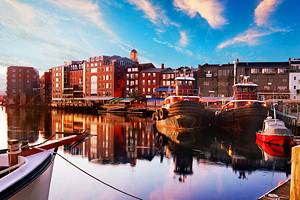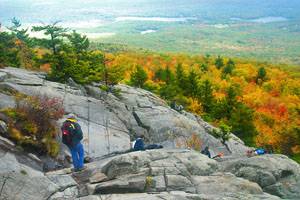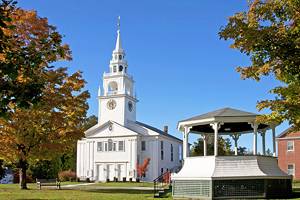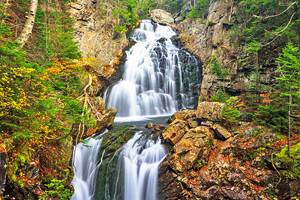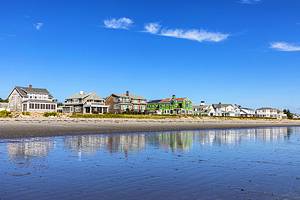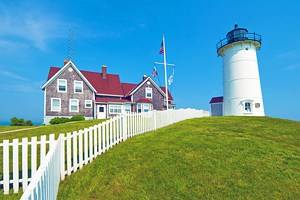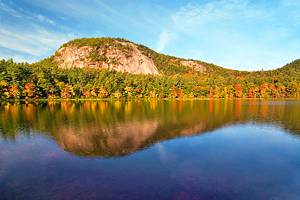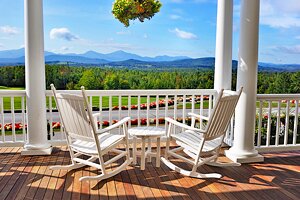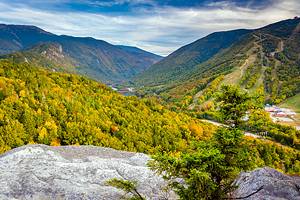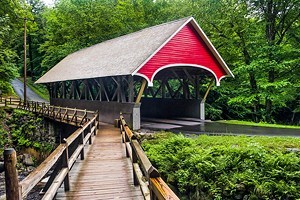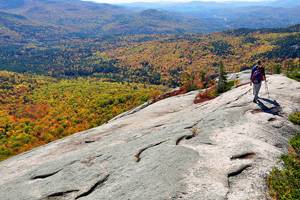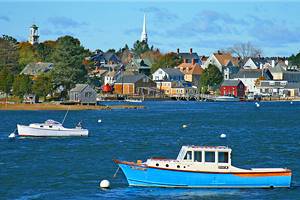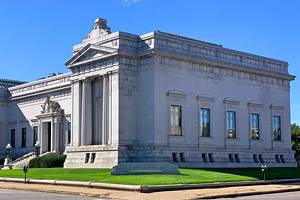Small Towns in New Hampshire
Of all the places to visit in New Hampshire, its small towns are the most characteristic of this largely rural state. Many of them still have their village stores, which serve as community meeting places, and every one of them has at least one white-spired church or meeting house.
Some look like postcards, clustered around their common; others are more scattered, some with several separate village centers within the same town.
These towns may be small, but you'll find plenty of things to do in these scenic New Hampshire destinations, from visiting a Shaker village in Canterbury to shopping in galleries and crafts co-operatives.
Small towns in New Hampshire appeal to all kinds of travelers. Sutton and Tamworth are popular places to go for families, each with an old-time farm museum and a lakeside beach; couples will have no trouble finding romantic country inns.
From historic New Castle on its island to Jackson and Franconia in the White Mountains, you'll find your sweet spot with this list of the best small towns in New Hampshire.
Walpole

Walpole's white clapboard and brick residences and stately public buildings are cited as "architecturally harmonious" by the National Register of Historic Places, so do walk along its short Main Street and around the grassy common to admire them. There's even a bandstand on the well-mowed green, with band concerts on summer evenings.
What brings the most tourists and locals to Walpole, however, is the combination of L.A. Burdick Handmade Chocolates and The Restaurant at Burdick's. The first is a world-famous chocolatier and the second a stylish café in the French bistro style.
Crowning a hill above Main Street, the Greek Revival-style Academy houses the collections of the Walpole Historical Society, including those related to Louisa May Alcott, who summered in Walpole.
Next to the classic Richardson Romanesque library, the Walpole Artisans Co-op is filled with well-chosen artworks, from beautifully designed silver jewelry to brilliantly colored fused glass.
Jackson

Before the days of the grand hotels, the scenic vistas and rugged beauty of the White Mountains were discovered by artists, and the area at the foot of Mt. Washington was among their favorite spots. Their paintings and engravings in newspapers drew the early tourists, who soon became regular summer visitors. Hotels grew larger and more elaborate as wealthy families became regular guests.
Thanks to the painters, known as the White Mountain Artists, and the tourists, Jackson became the social center of the Eastern Slopes. You can see some of the paintings that lured the early tourists at the Museum of White Mountain Art, near the scenic Jackson Falls.
That golden age ended, but despite losing many of the grand hotels, Jackson is again the queen of the White Mountain resort towns. The focal point of the attractive village center is The Wentworth, a grand hotel with stylish rooms and fine dining. Some of the former private summer homes — including The Inn at Thorn Hill and the Inn at Jackson — also welcome guests year-round.
In the winter, these inns cater to New Hampshire skiers at Black Mountain and nearby Wildcat, or at the Jackson Ski Touring Foundation, one of the best places for cross-country skiing in New Hampshire, with trails crisscrossing the valley.
In summer, Jackson is the gateway to Pinkham Notch and Mt. Washington.
Bethlehem

Set high along a ridge in the western White Mountains, Bethlehem gained early fame as a pollen-free haven for those with hay fever. Guesthouses and hotels sprang up, then wealthy city people began commissioning prominent architects to build "cottages" and country estates and design their gardens.
The big hotels are gone — only the stone casino remains from the Maplewood — but the cottages still line the streets, and one of the great estates has been beautifully preserved as Adair Country Inn & Restaurant. The inn has restored the gardens designed by Frederick Law Olmstead, one of two in Bethlehem.
The other garden is on a neighboring hillside at The Rocks Estate, now a Christmas tree farm and forest preserve with woodland walking trails and panoramic views of the White Mountains.
Main Street is lined with small shops, including The Gallery at WREN, a women's co-operative filled with quality crafts and fine art. Opposite is a restored Art Deco movie theater.
To identify more outstanding architectural highlights, stop at the visitor center for a self-guided walking tour map.
Sandwich

North of Lake Winnipesaukee and at the edge of the White Mountain National Forest, Sandwich is a classic New England village, its white church, Town Hall and houses overlooking a grassy park.
One of these, Elisha Marston House, contains the Sandwich Historical Society Museum, displaying early household furnishings, tools, textiles, and works by early local artists. Beyond the Grange Hall, the Quimby Barn houses a museum of antique horse-drawn vehicles, the star of which is a beautifully restored 1850 Concord Coach.
Sandwich has always been a magnet for the arts. Facing another green is the League of NH Craftsmen gallery, displaying works by local and statewide artists. Nearby is the Patricia Ladd Corega Gallery, featuring contemporary art.
Sandwich even has its own Shakespeare company, Advice To The Players, and the historic Corner House Inn in the center of town, serves up live music and regular storytelling dinners.
Tamworth

At the southern edge of the White Mountains, Tamworth lays claim to the best views of Mount Chocorua, the region's iconic stand-alone peak. One of the favorite things to do here on a summer evening is taking in a performance at The Barnstormers Theatre, the country's oldest ongoing professional summer theater.
The theater is in the village center, a few yards from the Remick Country Doctor Museum and Farm, a living museum where you can experience a 19th-century farm, watching — and participating in — demonstrations of kitchen, household, and farm activities.
Nature lovers should seek out Tamworth's Big Pines Natural Area, perhaps the best place to visit in all New England to see towering Eastern white pine trees. One white pine is 150 feet tall with a 15-foot circumference.
You can swim or pitch a tent under more tall pines in White Lake State Park, where the 72-acre stand of rare pitch pine trees has been named a National Natural Landmark.
Cornish

The gentle valley landscapes and views of Mt. Ascutney across the Connecticut River drew late-19th-century artists and other creative people to Cornish, where they established one of the country's best-known art colonies. The founder, and first to build a summer home here, was the already-prominent sculptor, August Saint-Gaudens.
His home, Aspet, became a magnet for others who built nearby, including the artist Maxfield Parrish. Today, Aspet and the adjoining studio and extensive gardens form Saint-Gaudens National Historic Park. In the New Studio are casts of some of his most famous works, and full-sized bronze casts of others, including the Standing Lincoln, are set outside amid the trees and flower beds.
Cornish has a total of 10 sites on the National Register of Historic Places, including four covered bridges. One of these, the longest wooden covered bridge in America, crosses the Connecticut River to Windsor, Vermont. All four bridges were built by the same untrained craftsman in the 1880s.
Wolfeboro

With fewer traditional family beach attractions than towns on the western side of Lake Winnipesaukee, Wolfeboro is a more sedate place for a lakeside vacation. You can tour the lake from here on the MV Mount Washington or on the vintage Millie B, operated by the NH Boat Museum.
The museum is on a smaller neighboring lake, where you'll find a beautiful beach at Wentworth State Park. Smaller beaches on Lake Winnipesaukee are south of Wolfeboro's compact village, where you'll find smart boutiques and galleries showing the works of regional artists and craftspeople. At the heart of the attractive lakeside center is a restored Victorian train station.
Clark Park contains a small group of buildings preserved by the Wolfeboro Historical Society: an authentically furnished 1778 home, a one-room school from 1805, an 1820s barn and a collection of antique fire-fighting equipment.
Between June and October, Clark Park is also the site of the Wolfeboro Area Farmers Market.
Hancock

Named for John Hancock, who owned about 1,000 acres of land here, Hancock is in the Monadnock region. Although he never lived here, many of the buildings lining its short main street date from Hancock's lifetime. If a stagecoach pulled up at the columned front porch of the Hancock Inn, it wouldn't look out of place.
The Hancock Inn opened in 1789, and while renovating in 1915, the owners uncovered early 19th-century murals by the famous itinerant painter, Rufus Porter, and later stencils by Moses Eaton, Jr. Restored, these murals and stencils decorate several guest rooms today (the inn is closed for renovations until May, 2023).
A four-chimney brick tavern down the street was built in 1800 and is now the Hancock Historical Society, a museum with antique furniture, textiles, and a large tool collection. These are only the beginning of the fine buildings that make up the Hancock Village Historic District, now on the National Register of Historic Places.
Along with several period homes, the district includes the Vestry, the Grange, and a schoolhouse, but most prominent — and picturesque — is the 1820 Hancock Meetinghouse and First Congregational Church, where Paul Revere bell #236 still chimes hourly around the clock.
Hancock's 1700-acre dePierrefeu – Willard Pond Wildlife Sanctuary is a pristine pond alive with birds, including loons. A favorite of kayakers, the sanctuary also has hiking trails that lead past giant glacial boulders.
Canterbury

The Canterbury Country Store has always been at the heart of the community, so much so that when it was in danger of closing, residents banded together to save it. Now owned by the community, it should be your first stop in town.
Along with everyday needs from motor oil to Himalayan sea salt, you'll find hand-made hats and mittens from a local alpaca farm, smoked meats from Fox Smoke House, maple syrup from Tamarack Farm, all local businesses. Fox Smoke House is worth a visit, too, for their rustic shop redolent with sweet smoky aromas.
In March, visit Tamarack Farm for a ride to their sugarhouse on a horse-drawn sled and a taste of warm syrup; it's a rite of spring here. In late summer and fall, head to Hackleboro Orchards for fresh-picked apples and cider donuts.
Canterbury's best-known attraction is the Canterbury Shaker Village, with 30 historic buildings where you can learn about the Shakers and their traditions of fine crafts and simple living. Founded in 1792, the village was active until 1992, when it became a museum.
New London

The stately brick halls and green lawns of Colby-Sawyer College give New London a gracious air that carries throughout its Main Street homes, businesses, and public buildings. Easy to spot is the red New London Barn Playhouse, a 90-year tradition of summer theater in the lakes region.
You might not be so quick to spot a New London secret — behind the Tracy Library a small garden designed by Frederick Law Olmstead and recently restored following the original layout and plant list. The striking contemporary fountain is by local metal artist Dimitri Gerakaris.
The arts play an important role in New London life, thanks to the Fine Art Gallery at Colby-Sawyer and the New London Center for the Arts. Both have exhibition galleries, the latter showcasing local artists through shows and First Fridays Programs.
Plan to spend some time touring the surprisingly extensive New London Historical Village, where 18 historic buildings have been gathered and filled with displays and artifacts. Volunteers will point out highlights, and you can explore on your own to find an 1820 schoolhouse, country store, blacksmith shop, houses, and barns.
Sutton

Travelers on Interstate 89 pass right through the entire length of Sutton and never see it for the forest. But there are a lot of reasons to stop and look around. The village of South Sutton is like driving into the middle of the 19th century, a placid green beneath the 1839 South Sutton Meeting House, remarkable for being in an almost original state.
Surrounding the green are an only slightly younger schoolhouse and several houses dating back as far as the mid-1700s.
North Sutton surrounds Kezar Lake, where the Penacook people camped in the summer to gather mussels. The sandy beach at Wadleigh State Park and its picnic grove are shaded by tall pines, birch, and hemlocks. Opposite is the gracious Follansbee Inn, whose guests have use of canoes and kayaks to explore the lake.
Beyond the lake, Muster Field Farm Museum is a group of historic farm buildings surrounding the Matthew Harvey Homestead, a grander residence than you'd expect in rural New Hampshire in the late 1700s. Tour it on Sunday afternoons in the summer to see the original hand-poured glass windows.
Barns, blacksmith shops, and a schoolhouse were moved here to save them and create a working farm museum preserving New Hampshire's agriculture heritage. Especially interesting is the icehouse, filled each winter with blocks of ice cut from Kezar Lake.
New Castle

New Hampshire's only town entirely on an island, New Castle is a warren of houses along streets so narrow that some of the front doors open right onto the roadway. Note the little signs on these historic homes; most date from the 1600s and 1700s.
The New Castle Historical Society offers walking tours, or you can just wander on your own to admire the well-preserved houses. At the far end, Fort Constitution (then called Fort William and Mary) was the site of the first armed military encounter of the Revolution, when the local Sons of Liberty seized ammunition, weapons, and other supplies from the British and hid them for later use at the Battle of Bunker Hill.
This is one of seven forts that protected Portsmouth Harbor, and you can see another, Fort Stark, by following Wild Rose Lane. Here, you can walk among the concrete batteries, unused since World War II. New Castle is home to New Hampshire's only seaside grand hotel, the venerable Wentworth by the Sea.
Franconia
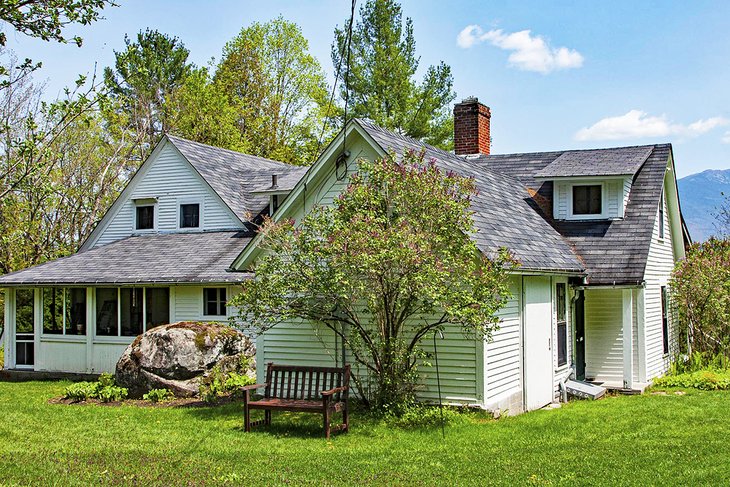
Even though its attractions and historic buildings don't cluster around a village green for a postcard shot, there's a lot of visual appeal in this town at the head of Franconia Notch. Begin by following the Franconia ArtWalk, a mile-long walking tour of Main Street and along the bank of the Gale River that reveals 31 arresting works of public art, as well as gardens, architecture, and riverscapes.
The route takes you from the school, where the students have created a sculpture garden and six wall mosaics, to a riverside path and along the main street. Stop to see the tall stone iron furnace beside the river, where iron from the mines on the hills above was smelted in the early 1800s. Outdoor panels and an interpretive center explain how it worked.
Above the village on Ore Hill is the home of poet Robert Frost, who lived here for five years and spent summers here for 20 more. You can tour the Frost Place and admire the views that lured him to this spot and inspired him to write some of his best-loved works here. A trail leads into the woods, marked by verses of his poetry.
Fitzwilliam

One of several postcard villages in the southwest corner of the state, Fitzwilliam's grassy common is surrounded by early-19th-century homes, the Community Church, and a majestic Town Hall. Its white bell tower rises even higher than the stately old trees that shade the common.
Also facing the green are an antiques shop; the three-story Fitzwilliam Inn; and the 1837 Amos J. Blake House, now the museum of the Fitzwilliam Historical Society. The inn, currently closed, was built in 1796 as a coaching stop.
Doorsteps of the Town Hall and other buildings are made from Fitzwilliam granite, a high-quality building stone that made Fitzwilliam one of the three most important sources of that stone in what became known as The Granite State. Fitzwilliam granite was used to build Union Station in Washington, DC. You can still see former quarries to the west along Route 119.
Nature lovers should walk through the 16-acre Rhododendron State Park, a designated National Natural Landmark, for the largest and most vigorous Rhododendron Maximum grove in central and northern New England, the northern limit of their range.


